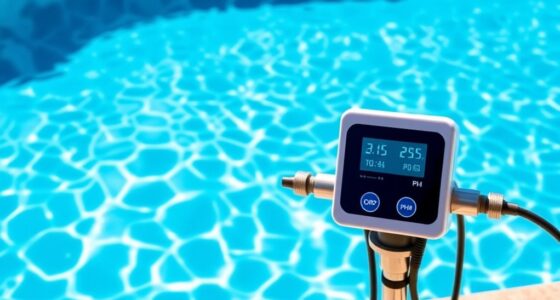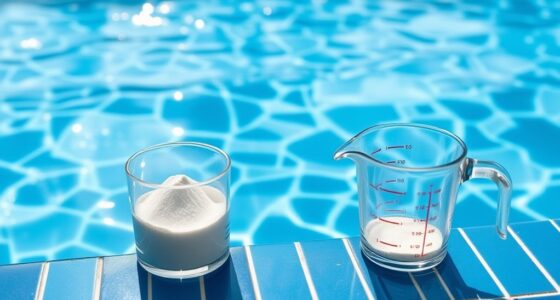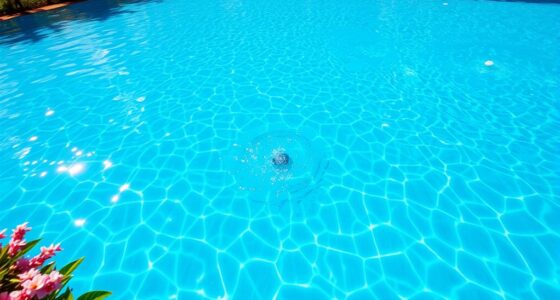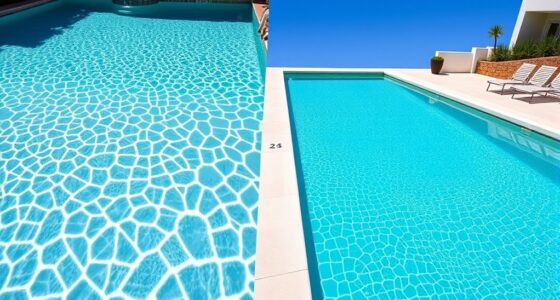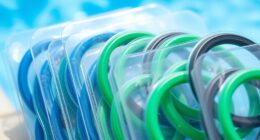Non-chlorine shock is a chemical treatment that quickly oxidizes organic contaminants, bacteria, and algae in your pool without the strong odors or skin irritation typical of chlorine. You apply it by testing your water, adjusting pH, and evenly spreading the shock over the surface while running your pump and filter. Regular use keeps your water clear and fresh. To learn more about proper application and safety tips, keep exploring how this effective treatment can benefit your pool.
Key Takeaways
- Non-chlorine shock uses oxidizers like potassium monopersulfate to oxidize contaminants without producing chloramines or odors.
- It effectively clears pool water by breaking down organic matter, bacteria, and algae, maintaining clarity and sparkle.
- Ideal for regular maintenance, especially after heavy use or storms, without disrupting chlorine levels or causing irritation.
- To use, test and adjust pH, ensure proper circulation, evenly distribute the shock, and run the filter for at least 8 hours.
- Always follow manufacturer instructions, wear protective gear, and store products safely to ensure safe and effective application.
Understanding Non-Chlorine Shock and Its Benefits
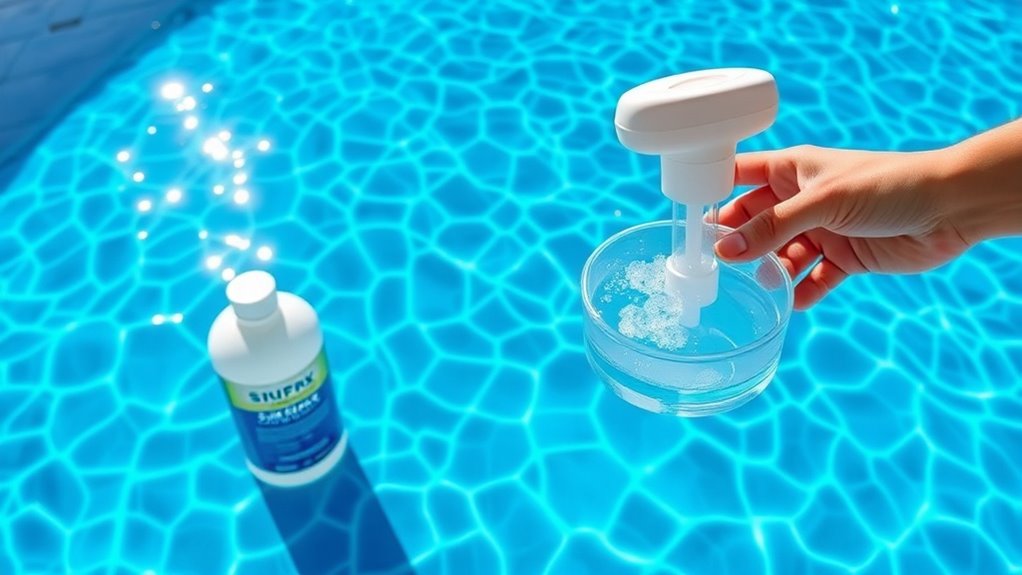
Non-chlorine shock is a popular alternative to traditional chlorine-based pool treatments, offering effective pool cleaning without the harsh chemicals. It works by oxidizing contaminants, breaking down organic matter, and reducing bacteria without creating strong odors or irritating your skin and eyes. This type of shock is ideal if you’re sensitive to chlorine or want to avoid its residual effects. Non-chlorine shock also helps maintain clear, sparkling water by controlling algae growth and reducing cloudy water. It’s easy to use, often requiring just a simple application after heavy use or storms. Plus, it doesn’t interfere with your regular chlorination schedule, making pool maintenance more convenient. Regular use can also help prevent issues like clogs and buildup, ensuring your pool stays in top condition. Additionally, because it doesn’t produce the strong chemical odors associated with chlorine, it is a safer option for those with sensitivities. Incorporating non-chlorine shock into your routine can also extend the life of your pool equipment by reducing chemical stress. Many non-chlorine shocks are formulated with oxidizers that are gentle yet effective, making them suitable for frequent use. Using non-chlorine shock can also be advantageous as it minimizes chemical residuals, which can be beneficial for pool water balance and swimmer comfort.
How Non-Chlorine Shock Works to Sanitize Your Pool
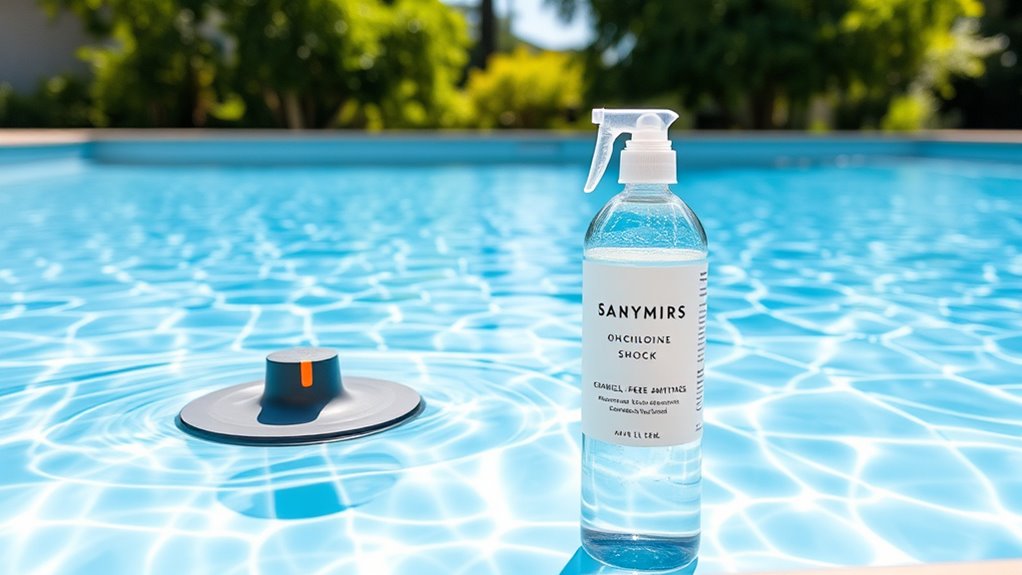
When you add non-chlorine shock to your pool, it works by rapidly oxidizing organic contaminants, bacteria, and algae that can cloud or foul the water. This process breaks down pollutants into harmless substances, restoring clarity and freshness. Unlike chlorine, it doesn’t produce strong odors or irritate your skin. The active ingredients, typically potassium monopersulfate, react quickly with contaminants, transforming them into inert compounds. This guarantees your pool stays clean without the harsh side effects of chlorination. Additionally, non-chlorine shock is a chemical-free alternative that reduces the need for frequent chemical adjustments in your pool. It is also effective at preventing algae blooms, helping maintain clear water throughout the swimming season. Fetal development is not affected by non-chlorine shocks, making it a safe option for maintaining water quality during the swimming season. Moreover, since it doesn’t rely on traditional chlorine, it reduces the risk of chlorine byproducts forming in your pool water.
Comparing Chlorine and Non-Chlorine Shocks

Both chlorine and non-chlorine shocks effectively sanitize your pool, but they do so through different mechanisms and with varying effects on water quality. Chlorine shock uses strong oxidizers to quickly eliminate bacteria, algae, and organic contaminants, providing immediate disinfection. However, it can leave behind chloramines, causing strong odors and eye irritation. Non-chlorine shock, on the other hand, relies on oxidizers like potassium monopersulfate to break down organic compounds without adding chlorine. It doesn’t produce chloramines or strong odors and is gentler on your skin and eyes. While chlorine shocks offer rapid sanitation, non-chlorine shocks are better for regular maintenance and when you want to avoid chemical smells. Regular use of non-chlorine shock can help maintain a cleaner, more comfortable swimming environment over time. Additionally, understanding the different water treatment methods allows you to select the most suitable shock for your pool’s specific requirements. Incorporating appropriate shock treatments regularly can help prevent algae growth and keep your water crystal clear, especially when considering the impact on water chemistry and overall pool health.
When and Why to Use Non-Chlorine Shock

You should consider using non-chlorine shock during regular pool maintenance or when you want to avoid the strong odors and skin irritation caused by chlorine-based products. It’s ideal for weekly shocking, especially if you swim frequently or have sensitive skin. Use non-chlorine shock after heavy bather loads, rainstorms, or debris, as these can introduce contaminants that require oxidation. It’s also useful when you want to quickly restore water clarity without adding more chlorine or risking chlorine burnout. Non-chlorine shock is perfect for maintaining balanced water chemistry while minimizing irritation. If you’re looking for a gentle, effective way to keep your pool clean and clear without the harsh smell, this product is a smart choice. Regular use of test strips can help monitor water chemistry and ensure optimal conditions. Additionally, understanding the oxidation process can improve your pool maintenance routine and prolong the life of your equipment. Proper water balance is essential to prevent issues like algae growth and cloudy water, and incorporating pH levels monitoring can further optimize water quality.
Step-by-Step Guide to Applying Non-Chlorine Shock

Applying non-chlorine shock correctly is essential for maintaining clean, clear water. First, test your pool’s pH level and adjust it to between 7.2 and 7.4 if needed. Next, verify your pump and filtration system are running to circulate the water. Measure the recommended amount of non-chlorine shock based on your pool size, then evenly distribute it across the water’s surface. Brush the pool walls and floor to loosen debris. Add the shock gradually, avoiding splashing or creating waves. Allow the filtration system to run continuously for at least 8 hours or overnight to help the shock work effectively. For optimal results, professional equipment can ensure your water chemistry remains balanced. Recognizing angel numbers can also provide insights into your emotional and spiritual readiness for love and transformation. It’s important to remember that proper water chemistry management not only keeps your pool safe but also extends the lifespan of your equipment. Maintaining proper remote work routines can contribute to a more efficient and stress-free cleaning process. Finally, retest the water to confirm clarity and chemical balance before swimming.
Tips for Maintaining Balanced Pool Water With Non-Chlorine Shock

Maintaining balanced pool water after using non-chlorine shock is essential for guaranteeing a safe and inviting swimming environment. First, test your water regularly using reliable test strips or a digital tester to monitor pH, alkalinity, and sanitizer levels. Keep pH between 7.2 and 7.8 to prevent irritation and ensure shock effectiveness. Adjust alkalinity if needed to stabilize pH. After shocking, wait at least 24 hours before swimming to allow the chlorine levels to normalize. Run your pump and filter continuously to circulate chemicals and debris, helping the water stay clear. Regularly clean your pool and skimmer baskets to prevent buildup. Consistent maintenance and testing will help keep your pool water balanced, safe, and pleasant for swimmers.
Common Mistakes to Avoid When Using Non-Chlorine Shock
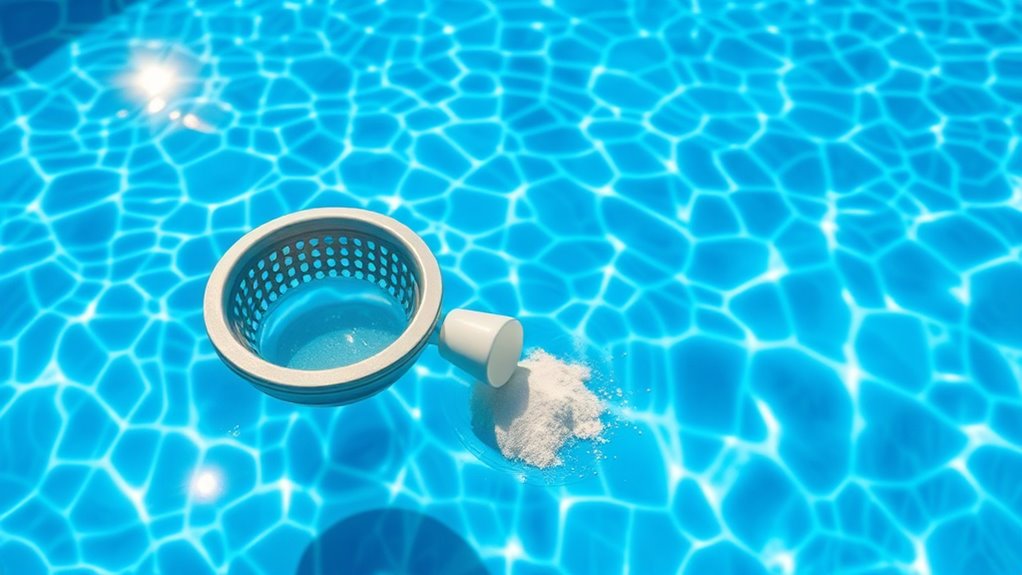
One common mistake is overusing non-chlorine shock, which can lead to imbalanced water and cloudy pools. You also need to pay attention to proper timing; shocking at the wrong moment reduces effectiveness and risks water issues. Ultimately, neglecting water balance before shocking can cause chemical reactions that harm your pool and equipment.
Overusing Shock Treatments
While it might seem tempting to use shock treatments frequently to keep your pool crystal clear, overdoing it can do more harm than good. Excessive shocking can lead to elevated pH levels, which may cause cloudy water and scale buildup. It can also stress your pool’s filter and equipment, reducing their lifespan. Overuse might also result in skin and eye irritation for swimmers due to higher chemical levels. Additionally, unnecessary shocking wastes your money and chemicals, making the process inefficient. Instead, use shock treatments only when your water tests indicate the need—such as after heavy use, storms, or visible algae. Following the recommended dosage and frequency helps maintain a healthy, balanced pool without risking damage or discomfort. Proper timing and moderation are key to effective pool management.
Ignoring Proper Timing
Ignoring the proper timing when using non-chlorine shock can undermine your pool’s clarity and safety. If you shock too early or too late, you risk ineffective results or even algae growth. Proper timing ensures your pool water can fully absorb the shock treatment and that the chemicals work as intended.
To avoid mistakes:
- Don’t shock immediately after heavy rain or heavy use; wait until water stabilizes.
- Avoid shocking during peak sunlight hours; do it in the evening or early morning.
- Never skip testing water parameters before shocking; imbalanced water can hinder the process.
Neglecting Water Balance
Neglecting to maintain proper water balance can substantially reduce the effectiveness of non-chlorine shock treatments. When your pool’s pH, alkalinity, or calcium hardness are out of range, the shock won’t work as intended. High pH levels can neutralize the shock’s oxidizing power, while low pH can cause corrosion and damage. Imbalanced water can also lead to cloudiness and scaling, making it harder for the shock to eliminate contaminants. Before applying non-chlorine shock, test your water and adjust chemicals accordingly. Consistently monitoring and maintaining proper water balance ensures the shock can do its job efficiently, keeping your pool clear, safe, and properly sanitized. Ignoring water balance compromises your efforts and can prolong issues that you might otherwise resolve quickly.
Safety Precautions for Handling and Applying Non-Chlorine Shock
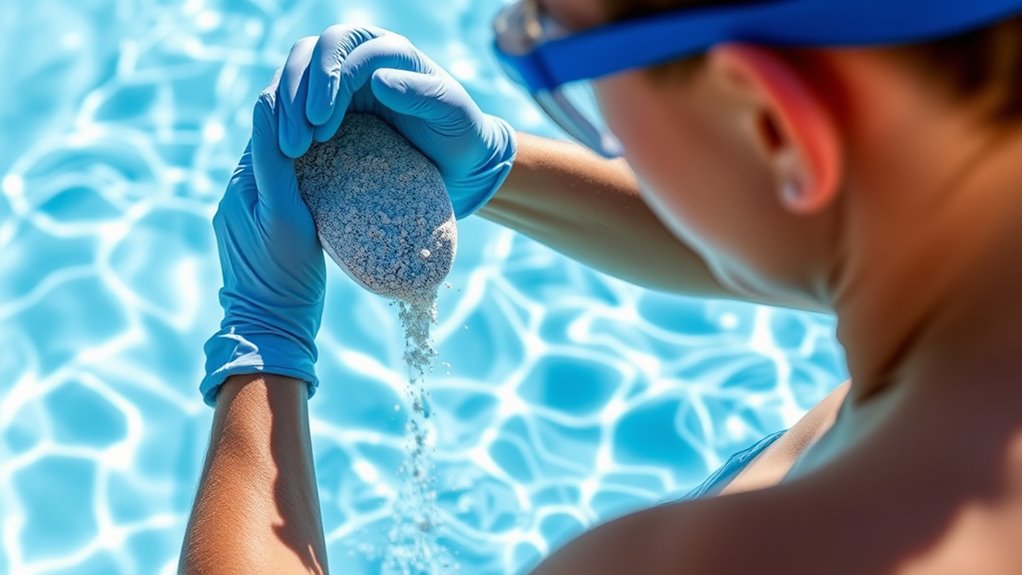
Handling and applying non-chlorine shock safely is crucial to prevent accidents and guarantee effective treatment. Always wear protective gear like gloves and goggles to avoid skin and eye irritation. Follow the manufacturer’s instructions carefully, including proper dosing and timing. Work in a well-ventilated area to prevent inhaling fumes. Keep non-chlorine shock away from children and pets, storing it in a secure, dry place. Never mix it with other chemicals, as reactions may occur. Be cautious when adding the shock to your pool—add it gradually to avoid splashing or over-concentrating. Regularly check your pool’s water chemistry to ensure proper application. Staying vigilant with these precautions keeps you safe and ensures your pool stays clean and healthy.
Best Products and Brands for Non-Chlorine Shock Treatments
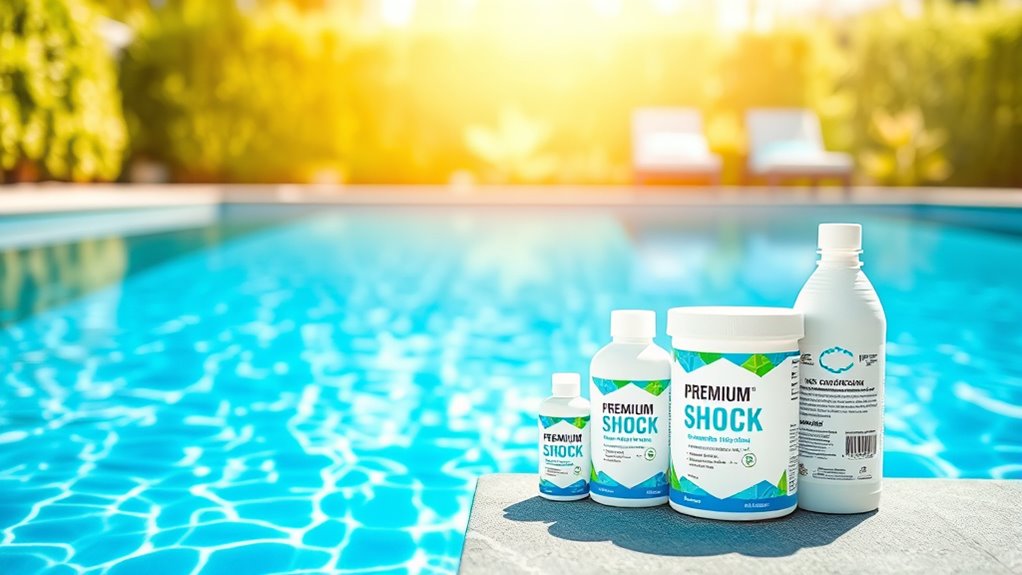
Looking for the best products and brands for non-chlorine shock treatments? You’ll want to choose reputable options known for effectiveness and safety. Brands like SpaGuard, Leisure Time, and HTH offer reliable non-chlorine shock products that quickly oxidize contaminants without harsh chemicals. SpaGuard’s Non-Chlorine Shock is popular for its fast-acting formula, ideal for regular maintenance. Leisure Time’s Shock Booster is another trusted choice, designed to restore water clarity and freshness. HTH’s Non-Chlorine Shock is easy to use and works well in various pool types. When selecting a product, consider your pool size and usage frequency. Always follow the manufacturer’s instructions for best results. These brands provide quality solutions to keep your pool clean and safe without the drawbacks of chlorine-based shocks.
Frequently Asked Questions
Can Non-Chlorine Shock Eliminate Algae in My Pool?
If you’re wondering whether non-chlorine shock can eliminate algae in your pool, the answer is yes, but with some caveats. Non-chlorine shock helps oxidize organic contaminants, which can improve water clarity and reduce algae growth. However, for heavy algae infestations, you might need a combined approach, including algaecides and proper brushing. Regular use of non-chlorine shock keeps your pool clean and prevents algae from taking hold.
How Often Should I Apply Non-Chlorine Shock?
You should apply non-chlorine shock about once a week or as needed, especially after heavy use, rain, or if your water looks cloudy. Regular shocking helps maintain clear, balanced water and prevents algae buildup. Always follow the product’s instructions for dosage and timing. Keep your pump running during and after application to circulate the chemicals and maximize effectiveness. Adjust frequency based on your pool’s specific conditions.
Is Non-Chlorine Shock Safe for All Pool Types?
You wonder if non-chlorine shock is safe for all pool types. Generally, it’s safe for most pools, including vinyl, fiberglass, and concrete, because it doesn’t contain chlorine or harsh chemicals that can damage surfaces. However, always check the product label and manufacturer’s recommendations before use. If you have a specific pool type or sensitive equipment, consult with a pool professional to guarantee compatibility and safety.
Does Non-Chlorine Shock Leave Any Residual Smell or Taste?
Does non-chlorine shock leave any residual smell or taste? Think of it like a gentle breeze after a storm—refreshing without lingering harshness. You won’t notice strong chemical odors or tastes after using it because it doesn’t produce chloramines or chlorines that cause that. Instead, it oxidizes contaminants quietly, leaving your pool smelling clean and tasting fresh, so you can enjoy your swim without worries about unpleasant residues.
Can I Swim Immediately After Applying Non-Chlorine Shock?
You might wonder if you can swim right after applying non-chlorine shock. Generally, yes, you can, but it’s best to follow the product instructions. Many non-chlorine shocks are quick-acting and don’t require you to wait long. However, for safety and to guarantee the chemical disperses properly, wait a few minutes or as recommended. Always check your pool’s chemical levels before jumping in to keep your swim safe and enjoyable.
Conclusion
Choosing non-chlorine shock offers a gentle yet effective way to keep your pool clean, contrasting the harshness of traditional chlorines. While it preserves your water’s clarity and your skin’s comfort, ignoring proper application can lead to cloudy water or algae growth. By understanding its benefits and following best practices, you can enjoy a pristine, inviting pool—where safety and freshness coexist effortlessly, proving that sometimes, gentle solutions deliver the strongest results.


